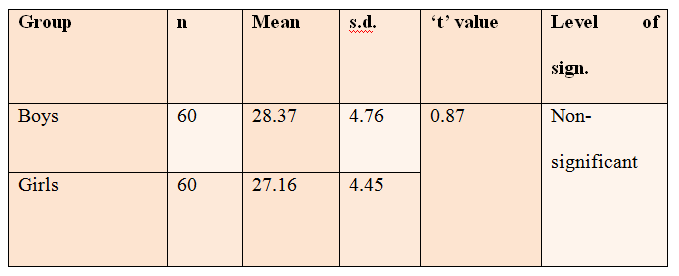
A Study of Personality Characteristics in High School Students with Relation to Their Gender
ABSTRACT ::
Personality plays an important role in our life. An attempt has been made to measure personality characteristics (neurosis- emotional stability and introversion- extroversion) of high school students with relation to their gender. The sample consisted of 120 high school students of Gandhinagar city of Gujarat state. Personality of the sample was measured by M. P. I.’s Guajarati version. The result indicates that there is no significant difference between the neurosis – emotional stability characteristics of boys and girls. It could be also seen that boys and girls do not differ in their scores of introversion- extroversion characteristics.
Introduction : -
Personality defined as the characteristic pattern of behavior and modes of thinking that determine person’s adjustment to the environment. Psychologists would say that personality consists of an individual’s characteristics and distinctive ways of behavior (Morgan, 1993). Characteristics, because they represent usual or typical behavior. Distinctive, because they differentiate a person from other people. Personality is individual’s unique and relatively stable patterns of behavior, thoughts and feelings (Neson & Miller, 1995). There are many ways in which people in a society are much same: in ours, most children of school age go to school regularly, and most people eat three meals a day. But in the study of personality, only the way in which one person differs from another are important. If a schoolchild plays hooky a lot, or if a person eats too much or too little, these are distinctive personality characteristics (Morgan, 1993). According to Sigmund Freud conscious, preconscious and unconscious are three levels of consciousness that pays an important role on our personality. The three basic parts of personality are id, ego and super ego, whish correspond roughly to desire, reason and conscience. He believed that all human beings move through a series of psychosexual stages. Humanistic theories of personality suggest that people strive for personal development and growth; in contrast, psychoanalytic theory views human being are constantly struggling to control the sexual and aggressive impulses of the id. Rogers believed that many individuals fail to become fully functioning persons because distorted self-concepts interfere with personal growth. According to Maslow, self- actualization is a stage in which an individual has reached his/her maximum potential and becomes the best human beings he/she can be. Allport suggested that human beings possess a small number of certain traits that account for much of their uniqueness as individual. According to Cattell, there are sixteen source traits that underline differences between individuals on many specific dimensions (Baron, 2007). Adolescence is the period where personality gets changed dramatically. In India, a student of higher secondary is neither a child nor an adult. This period of transition affects on their personality and boys and girls differ in their changes.
Objective:
Objective of this study is to measure two different personality characteristics – neurosis-emotional stability and introversion-extroversion of high school students with relation to their gender.
Hypothesis:
Sample:
The sample consisted of 120 high school students with equal number of boys and girls drawn from the different high schools of Gandhinagar city of state.
Tools:
To measure personality, M. P, I,’s was used. The test was developed by Izenk. The Gujarati standardization was made by Dr. D. J. Bhatt. The test measures two personality characteristics, neurosis-emotional stability and introversion-extroversion. It consists of 48 questions and the subject has to give his/her answer in ‘Yes’, ‘?’, ‘No’.
Reliability:
As per the method of test-retest, the reliability for introversion-extroversion scale is 0.76 and for neuroses-emotional stability it is 0.74. As per the Spearmen-Brown’s formula, the reliability for introversion-extroversion is 0.86 and for neurosis-emotional stability it is 0.94.
Validity:
The validity of the test is found out with English and Indian version and it was reported to be significant.
Procedure:
The sample of 120 high school students was selected randomly. It consisted of 60 boys and 60 girls. After giving them proper instructions, the test was administered and obtained data were analyzed.
Result and Discussion:
TABLE-1: Neurosis-emotional stability characteristics

Table-1 shows the mean for 60 boys and 60 girls students are 23.42 and 26.05. The S.D value for 60 boys and 60 girls students are 4.64 and 5.43. The ‘t’ value for boys and girls students, which is 0.58, has been found no significant at 0.05 level. This result supports hypothesis (1).
TABLE-2 Introversion-extroversion characteristics

>Table-1 shows the mean for 60 boys and 60 girls students are 28.37 and 27.16. The S.D value for 60 boys and 60 girls students are 4.76 and 4.45. The ‘t’ value for boys and girls students, which is 0.87, has been found no significant at 0.05 level. This result supports hypothesis (2).
References::
***************************************************
Dr. N. J. Gadhavi
Department of Psychology,
M. N. College, Visnagar.
Email- njgadhavi8@gmail.com



Home | Archive | Advisory Committee | Contact us